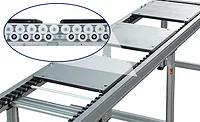Viscosity sensors
Inline viscosity sensing provides better batter control
Coupled with Industry 4.0 technology, inline sensing means no more rushing grab-samples to the lab, introducing quality issues with food products
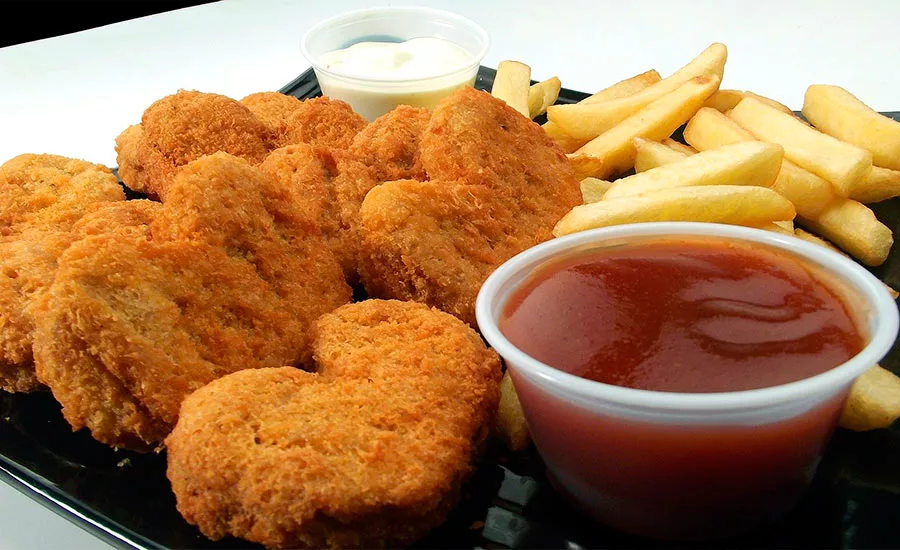
Consistency of the batter for fried chicken is all important to maintain quality, and in-line viscosity monitoring and control can get it right all the time, as opposed to waiting for grab-sample results from the lab, which will never be the same as what's in the pipe.
Image by ALFONSO CHARLES from Pixabay
Batter is widely used as a coating for deep-fried foods as well as many other products such as cakes, waffles, biscuits, and pancakes. When used as coating, the batter is typically applied by dipping, or spraying onto continuous baking drums and oven bands. Depending on the type of food product, the processing objectives and challenges may be different but one thing is certain—food companies strive to meet their requirements of consistent quality and freshness by developing innovative products, while lowering production costs and easing maintenance.
Many processed foods are coated with starch-based batters to enhance flavor and add texture—and contribute to the identity and appeal of the particular product. ‘Battering’ or ‘coating’ may be done to give the product certain additional properties, such as ‘bite’ (crispness), color or taste. The products being coated include chunks of raw or pre-processed food items like poultry, meat, sea food and vegetables, as well as extruded or molded food items. The batter coating can be applied via bath, waterfall or spray and cover one side or the complete piece. A key requirement for automated coaters is the uniformity of the coating making it vital to ensure the consistency of the batter is maintained as it is applied by the coater.
Batter viscosity is crucial to functionality
Consistency of the batter during coating is crucial to ensuring cost-effective, repeatable and uniform product.1 Viscosity plays a super-sized role in ensuring controlled consistency of batter mixes. However, ensuring and monitoring viscosity of batter mix or coating is not trivial. Batters are complex fluids. They typically consist of a number of dispersed phases such as flour, fat, water and air. Sufficient viscosity is required to stop phase separation during mixing, floor time and baking in the oven. For highly viscous batter systems, there is usually sufficient viscosity to stop phase separation and to trap and retain air, which is required for breads. However, for less viscous batter systems, as for wafers and puddings, there is a possibility of loss of air beaten into the batter during mixing, and separation of phases, which can be detrimental to the end product quality. 2
Cake batters need to be sufficiently viscous to prevent loss of gas bubbles during mixing. These bubbles are produced by rising agents and steam, which cause expansion and reduce batter density. Batter becomes thinner as it heats up in the oven, thus increasing the likelihood of phase separation of the denser components, such as starch granules, which may sink to the bottom of the baking tin. The separation of recipe components, therefore, needs to be prevented by maintaining the right viscosity up to the point where the product’s structure is set.
Types of batter
For adhesion batters, viscosity is important. It can be set by using different starch blends and gums, and is influenced by the degree of starch damage during heat treatment. Changes in the water-powder ratio are also used to manage batter viscosity. Viscosity, along with temperature, is key to obtaining the desired coating pickup, adhesion and texture. The liquid batter coagulates (hardens) during later heat treatment stages (where applicable) to form a continuous structure incorporating all layers of coating and firmly adhered to the substrate. Batter pick up can be controlled through viscosity adjustment and the use of air blowers to remove the excess.
Cohesion batters are thicker than adhesion batters and are usually flour based. They contain a medium amount of solids, exhibit a longer drying time and higher viscosity (as compared with adhesion batters), and are used to provide texture to this layer.
Tempura batters are cohesion batters containing significant amount of leavening agents. They are made from a mixture of flour and starch, have high solid content, and are highly viscous. The batter is designed to have good cohesive characteristics and as a result of leavening ingredients, forms a layer rich in air pockets.
Breading
Breading is a way to seal in the flavors of a prepared dish maintaining intense flavor and proper texture despite storage. Several studies show the influence of batter viscosity on breading of chicken drumsticks.3 A breading is defined as a dry mixture of flour, starch, and seasonings, coarse in nature, and applied to moistened or battered food products prior to cooking. The most prevalent of coated foods is a breaded product where a coating is usually applied on top of an adhesive batter on a pre-dusted substrate. Generally, batter or breading pickup is directly correlated with batter viscosity; that is, as viscosity increases, more batter and breading remain on the substrate. Tight control of batter viscosity also helps in minimizing cooking losses and achieves desired breading adhesion. Batter viscosity and pickup (percent coating weight) ratio are intricately related for breading batters.
The quality of foods such as soups, sauces, gravies, custards, flans, desserts, and baked products—to name a few—depend heavily on structure-forming properties of materials such as starch. If the viscosity of the prepared mixture is incorrect, starch granules may swell, become fragile and can break down under shear. This can badly affect the quality of the product.
Processes in batter: Where viscosity is important
Viscosity is the key to achieve target properties in each of the following steps in batter production:
- Batter preparation unit (mixer): In this step, correct amount of powder is dosed into the mixing system, where it will be mixed with water. Batter mixes are usually prepared on a batch basis and discharged to a holding tank prior to use. The prepared mix must be consistent and must have the correct viscosity characteristics for further processing steps, leading to the desired end product quality.
- Applicator unit (coating): Once the batter has reached a desired viscosity, a variable speed feed pump is used to forward the batter to an applicator where the food product is coated. The prepared batter system from mixer is passed through heat exchangers to get the optimal temperature for coating. The batter is then applied or sprayed onto the food to be coated before further processing. Correct viscosity during the coating process is key to ensuring correct and consistent thickness of batter coat.
Ensuring consistency: Viscosity management is crucial in batter mixing and coating
There are four significant factors that make viscosity management important in virtually every batter mixing application:
- Maintaining consistent quality: Viscosity determines key properties of the produced wet batter mix. Under-mixing will give rise to non-homogeneity and over-mixing will affect the texture and may increase “lumpiness.” To ensure consistent batter performance from batch to batch, viscosity control is essential.
- Reducing costs by reducing waste: Over-mixing can not only affect the quality of end product but wastes ingredients, raw materials, time and energy. Viscosity management in the mixing process can identify the endpoint reliably and accurately, thus leading to significant reduction in rejects and waste.
- Efficiency: Hassle-free, real-time monitoring of mix viscosity eliminates the costly and time-consuming laboratory analysis, which often results in delayed response to changes in the batter properties.
- Automation: Automatically monitoring and controlling batter mixing and coating process takes out a manual task that is prone to errors and relieves operators to focus on the quality of the final product.
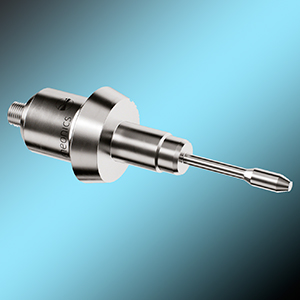 |
| Rheonics' SRV (DIN 11851) inline viscosity sensor has built-in temperature measurement, and can be inserted inline with existing equipment. Photo: Rheonics |
Advantages of inline viscosity monitoring: Reducing key battering defects
Typical defects in batter mixing and coating applications due to inaccurate viscosity control are:
- Voids in coatings
- Poor adhesion
- Tingeing (discoloration of coating)
- Underweight or overweight product
- Skirting at the edge of the product
- Soft doughy underlayer
These defects can lead to significant waste in production, and return of products that do not meet customer requirement. This, in turn, can damage reputation, incur large costs for correcting deficiencies, and even lead to manufacturer liability claims.
Process monitoring and control challenges
Process optimizations achieved through viscosity automation contribute to overall sustainability and reduce costs. Mixing operators in the food industry recognize the need to monitor viscosity for consistent mix and pick-up but making that measurement has challenged process engineers and quality departments over the years.
Challenges with traditional viscosity measurements
Batter is an inherently non-Newtonian fluid, whose apparent viscosity is highly dependent on the method and parameters of the measurement system. Existing laboratory viscometers are of little value in process environments because viscosity is directly affected by temperature, shear rate and other variables that are very different off-line from what they are in-line with the process. Typically, flow cups are used to measure the viscosity of batter. But because the laboratory measurements are made under flow conditions that are different from those in the process, the off-line (sampled, lab) viscosity measurement may not give a true representation of the batter mix. Off line measurement is cumbersome, time-consuming, and often non-repeatable, even with an experienced operator. Laboratory viscometers are susceptible to unreliability and measurement inaccuracies due to the inherently large errors in measurement of shear-dependent fluids, as well as inter-operator variability.
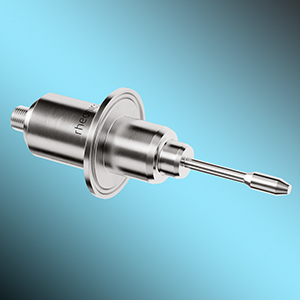 |
| Rheonics' SRV inline viscometer is also available in tri-clamp mounting/connections. Photo: Rheonics |
Therefore, batter mixing and coating systems need the ability to accurately measure the actual viscosity of the batter or ingredients under actual process conditions. Ideally, mixing and coating systems should be provided with an in-line viscometer to be used with a closed-loop control system for monitoring and controlling the production processes involved in a batter processing and coating.
Digital food processing: Driver for manufacturers’ embrace of Industry 4.0
Temperature fluctuations, mixing equipment condition, type and conditions of substrates, batter formulations, process step interactions and mixing time parameters can all alter the product quality and performance across batches in batter mixing and coating. In thin-margin sectors like baked goods, batter-coated foods, and confectionery, the downtimes and delay in deliveries due to rejects can seriously hurt profitability. Most of these parameters can be controlled by a system that continuously monitors the batter characteristics and takes corrective actions automatically and adaptively without disrupting the process flow.
Technologies required to deliver such transformational changes in the manufacturing process for food manufacturers already exist. Once the food manufacturer invests in process monitoring equipment and analyses the collected data the system provides, it gives them a fair idea to calculate where productivity gains can be made, where energy savings can be achieved and how to reduce downtimes through predictive maintenance.
The key value drivers for investing in a continuous production process, supported by real-time inline viscosity monitoring equipment by food manufacturers and system integrators in batter mixing and coating are the following:
- Automated corrective actions for ensuring product consistency: Closed control loops through sensor-based, in-line quality inspection reduce waste and increase yield through early process deviation detection, root cause analysis, and automatic correction.
-
More agility in dealing with new product variants in food production, compliance and product provenance: Food manufacturers get a more accurate picture of how the new formulations or recipe changes will react and how they might need to adjust current systems and control parameters. Real-time monitoring facilitates transition of a batch-based process to continuous operation, saving significant operational and capital costs through re-use of the same lines for multiple products.
Using sensors to monitor batter mix is key to adapt to changing raw materials and end-product requirements, continuously changing regulations for food industry and managing growing demands of an increasingly better-informed customer base. - Acquired data provides robust evidence to base decisions for greater efficiency: The data provided by the process monitoring equipment enables operators to optimize process parameters critical to the manufacturing process. Interconnection and information transparency allow for operators to make decisions both inside and outside of production facilities, thus enabling decentralization of decisions. Automated and transparent processes, along with optimized workflows can ensure an efficient data management and improved quality control system.
- Higher customer satisfaction and adapting to customer requests: Industry 4.0 solutions impact food manufacturing companies by driving closer interactions with customers. The technology, data, and information help transform manufacturing operations making the company more responsive to customer needs.
Creating consistent batter coating: Inline monitoring
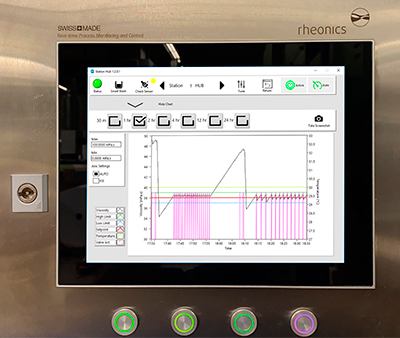 |
| Combine inline viscosity sensors with Rheonics' Production Monitoring and Control System to obtain consistent viscosity of batter and product quality. Photo: Rheonics |
Food manufacturers strive to satisfy consumers’ often cited several textural and mouthfeel properties as the basis for why they like the “taste” and how the texture and mouthfeel, combined with health consciousness and demand for clean-label products influences continued consumption decisions.
Automated in-line viscosity measurement enables continuous monitoring of batter during mixing at the point of application during coating. It enables control of the viscosity to assure uniform quality of the final product. For example, the Rheonics’ SRV Viscometer4 is a compact in-line process viscometer with built-in fluid temperature measurement.5 Its fast response time detects viscosity fluctuations in the process stream in real time, allowing corrective action to be taken as soon as deviations occur. Inline viscosity management with the SRV sensor can help alleviate common issues like batter voids, poor adhesion, tingeing, underweight or overweight products that can negatively impact the quality of final food products.
The SRV sensor can be placed in line with existing equipment, allowing it to continuously measure the viscosity (and density in case of Model SRD sensor) as the batter is being mixed, transported and applied. The basic monitoring system can alert the operator that intervention is necessary. It can also be integrated into existing mixing, transport and application systems for real-time viscosity control. Alternatively, the entire system can be fully automated using the Rheonics Predictive Tracking Controller (RPTC). Using the SRV sensor in batter mixing or coating line results in improved productivity, profit margins and regulatory compliance.
Once the process parameters are established, there is little effort required to maintain the integrity of the process. Operators can rely on the tight control provided by the Rheonics batter quality management solution and reap benefits not only in production, but also the product R&D stage when the formulation parameters are established. This enables the operator to gain competitive advantage as production is scaled up to meet increasing demand.
Key value of inline batter consistency monitoring and control solutions
As noted previously, the Rheonics SRV viscosity sensors have built-in temperature measurement, permitting the temperature of the batter mix to be monitored at the point of application. This permits the viscosity readings to compensated for temperature, which is essential for ensuring consistent production through typical daily and seasonal temperature variations.
Closed quality control loops and the increasing degree of viscosity automation enabled by the SRV viscometers add value to the production process in terms of quality, consistency, reduced wastes, efficiency and productivity. Human error is avoided, and fully automatic correction of any deviation in the manufacturing process becomes possible.
Data provided by the Rheonics viscometers and integrated solutions helps to accelerate learning curves and accommodate more frequent food product composition changeovers, contributing to a more resource-efficient, economical and greener manufacturing process.
In cases where asset productivity and OEE are key and maintenance costs are significant, actionable data provided by the viscometer solution helps food manufacturers cut down on process interruptions with predictive maintenance for production tools and machines. Forecasting potential downtime events and quality diagnosis are enabled by data provided by the sensors.
As food manufacturers seek to become more agile in adapting to consumers’ changing lifestyle and preferences, they understand the need to invest in R&D activities and advanced process control technologies to develop new formulations with tailored characteristics. Rheonics inline viscometers provide food manufacturers with capabilities to produce superior quality and consistent batter-coated products of great variety, with the least involvement of operators on factory floor—a significant advantage over other measurement alternatives or process control solutions. Inline blending with continuous viscosity monitoring solutions solves major challenges of batch production processes such as losses during product changeovers and inefficacies of ingredient handling in a recipe-based approach. It supports scaling up of blending capacities with ease.
There are many benefits to using an inline viscosity sensor like the SRV for batter mixing and coating applications. and some include:
- Works accurately in most coating systems with a broad range of batter compositions and related products—adhesion batter, glazes, sauces, marinations, breaders, pre-dust
- Maintains the set batter viscosity even while water or breading from the product mixes with the batter in the batter applicator during production.
- Rugged, hermetically sealed sensor head. The SRV can be cleaned inline with all standard CIP processes, or with a wetted rag, without the need for disassembly or recalibration
- No moving parts to age or foul with sediment
- Insensitive to particulate matter; no narrow gaps to foul with particulates
- All wetted parts are 316L stainless steel—meets sanitary norms with no corrosion problems
- Hygienic, sanitary design for food and beverage applications—available in tri-clamp and DIN 11851 connections for easy operation and cleaning
- Certified under ATEX and IECEx as intrinsically safe for use in hazardous environments
- Wide operational range and simple integration—Sensor electronics and communication options make it extremely easy to integrate and run in industrial PLC and control systems.
References
- L. Wang and D. R. Suderman (2011), “Application of Batters and Breadings to Various Substrates,” in Batters and Breadings in Food Processing, pp. 243-261 https://doi.org/10.1016/B978-1-891127-71-7.50019-X
- S.M. Fiszman, T. Sanz and A. Salvador (2013), “13 - Instrumental assessment of the sensory quality of baked goods,” in Instrumental Assessment of Food Sensory Quality, pp. 374-402 https://doi.org/10.1533/9780857098856.3.374
- F.E. Cunningham and L.M. Tiede (1981), “Influence of Batter Viscosity on Breading of Chicken Drumsticks,” in Journal of Food Science, 46(6): 1950-1950 https://doi.org/10.1111/j.1365-2621.1981.tb04527.x
- SRV inline viscometer: https://rheonics.com/products/inline-viscometer-srv/
- SRV operating principle: https://rheonics.com/whitepapers/
For more information, contact info@rheonics.com.
About Rheonics
Rheonics was founded to bring robust plug and play instruments for viscosity and density monitoring, two of the key physical properties of a process fluid. The founding team came from leading universities and global companies to build intelligent fluid process monitoring instruments. The team is supported by an advisory board made of technology leaders from the industrial automation and process industry.
Website: https://rheonics.com
Looking for a reprint of this article?
From high-res PDFs to custom plaques, order your copy today!






